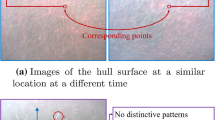Abstract
A prototype system has been built to navigate a walking robot into a ship structure. The robot is equipped with a stereo head for monocular and stereo vision. From the CAD-model of the ship good viewpoints are selected such that the head can look at locations with sufficient features. The edge features for the views are extracted automatically. The pose of the robot is estimated from the features detected by two vision approaches. One approach searches in the full image for junctions and uses the stereo information to extract 3D information. The other method is monocular and tracks 2D edge features. To achieve robust tracking of the features a model-based tracking approach is enhanced with a method of Edge Projected Integration of Cues (EPIC). EPIC uses object knowledge to select the correct features in real-time. The two vision systems are synchronised by sending the images over a fibre channel network. The pose estimation uses both the 2D and 3D features and locates the robot within a few centimetres over the range of ship cells of several metres. Gyros are used to stabilise the head while the robot moves. The system has been developed within the RobVision project and the results of the final demonstration are given.
Access this chapter
Tax calculation will be finalised at checkout
Purchases are for personal use only
Preview
Unable to display preview. Download preview PDF.
Similar content being viewed by others
References
Alferez, R., Wang, Y.F.: Geometric and Illumination Invariants for Object Recognition, IEEE Transactions on PAMI 21(6), 1999, pp. 505–536.
C. G. Bräutigam: A Model-Free Voting Approach to Cue Integration, Dissertation, KTH Stockholm, 1998.
J.S. Beis, D.G. Lowe, Indexing without Invariants in 3D Object Recognition, Pattern Analysis and Machine Intelligence, Vol.21,No.10, 1999, pp. 1000–1015.
J.R. Beveridge, E.M. Riseman, How Easy is Matching 2D Line Models Using Local Search?, Pattern Analysis and Machine Intelligence, Vol.19,No.19, 1997, pp.564–579.
H.I. Christensen, D. Kragic: Robust Vision for Manipulation and Navigation, in: Markus Vincze (ed.): Proc. Robust Vision for Industrial Applications 1999, 23rd Workshop ÆAGM/AAPR. [Del00] Deliverable of the RobVision project, also available from http://www.robvision.infa.tuwien.ac.at, 2000.
Dickinson, S.J., Wilkes, D., Tsotsos, J.K.: A Computational Model of View Degeneracy, IEEE Transactions on PAMI, vol.21,no.8, 1999, 673–689.
C. Eberst, M. Barth, et.al., Robust Vision-based Object Recognition Integrating Highly Redundant Cues for Indexing and Verification, IEEE ICRA 2000, pp. 3757–3764.
Förstner, W. and Gülch, E., (1987): A Fast Operator for Detection and Precise Location of Distinct Points, Corners and Centers of Circular Features; ISPRS Intercommission Workshop, Interlaken.
Fuerst, S., Dickmanns, E.D.: A Vision Based Navigation System for Autonomous Aircraft; Robotics and Autonomous Systems 28, pp.173–184, 1999.
A. Gasteratos and G. Sandini, On the Accuracy of the Eurohead, LIRA–TR 2/00, July 2000.
Grimson, W.E.L.: Object Recognition by Computer, MIT Press, 1990.
Hager, G. and Toyama, K. (1998): The XVision-System: A Portable Substrate for Real-Time Vision Applications, Computer Vision and Image Understanding, 69(1), 23–37.
Garding, J. and Lindeberg, T. (1994): Direct Estimation of Local Surface Shape in a Fixating Binocular Vision System, in: J. O. Eklundh, Lecture Notes in Comp. Science, 800, 365–376.
D.S. Kim, R. Nevatia, Recognition and localization of generic objects for indoor navigation using functionality, Image and Vision Computing 16(11), Special Issue SI, 1998 Aug 1, 729–743.
Kosaka, A., Nakazawa, G.: Vision-Based Motion Tracking of Rigid Objects Using Prediction of Uncertainties; ICRA, pp.2637–2644, 1995.
D. Kragic, H.I. Christensen, Cue Integration for Manipulation, in [21], pp. 1–16.
P. Krautgartner, M. Vincze: Optimal Image Processing Architecture for Active Vision Systems; Int. Conf. on Vision Systems, Gran Canaria, S. 331–347, January 13–15, 1999.
P. Pirjanian, H.I. Christensen, J.A. Fayman, Application of Voting to fusion of Purposive Modules: An Experimental Investigation, Robotics & Autonomous Sys., Vol.23, 1998, pp. 253–266.
Smith, S. M. and Brady, J. M. (1997): SUSAN-a new approach to low level image processing, Int. Journal of Computer Vision, 23,(1), 45–78.
M. Vincze, M. Ayromlou, W. Kubinger: An Integrating Framework for Robust Real-Time 3D Object Tracking; Int. Conf. on Vision Systems, Gran Canaria, S. 135–150, January 13–15, 1999.
M. Vincze, G.D. Hager, Eds., Robust Vision for Vision-Based Control of Motion, IEEE Press, 2000.
M. Vincze: Robust Tracking of Ellipses at Frame Rate; Pattern Recognition 34(2), 487–498, 2001.
Wunsch, P., Hirzinger, G.: Real-Time Visual Tracking of 3-D Objects with Dynamic Handling of Occlusion; ICRA, pp.2868–2873, 1997.
A. Zisserman, D. Forsyth, et.al., 3D object recognition using invariance, Artificial Intelligence, Vol.78, 1995, pp. 239–288.
Author information
Authors and Affiliations
Editor information
Editors and Affiliations
Rights and permissions
Copyright information
© 2001 Springer-Verlag Berlin Heidelberg
About this paper
Cite this paper
Vincze, M. et al. (2001). A System to Navigate a Robot into a Ship Structure. In: Schiele, B., Sagerer, G. (eds) Computer Vision Systems. ICVS 2001. Lecture Notes in Computer Science, vol 2095. Springer, Berlin, Heidelberg. https://doi.org/10.1007/3-540-48222-9_18
Download citation
DOI: https://doi.org/10.1007/3-540-48222-9_18
Published:
Publisher Name: Springer, Berlin, Heidelberg
Print ISBN: 978-3-540-42285-3
Online ISBN: 978-3-540-48222-2
eBook Packages: Springer Book Archive




